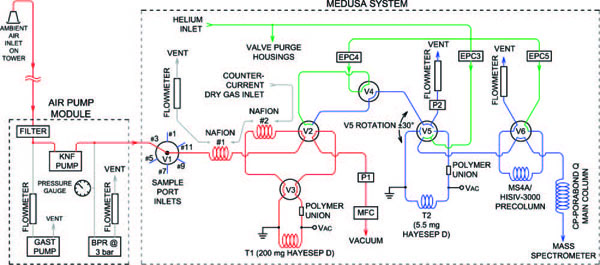Medusa system
The Medusa preconcentrator was jointly developed between Scripps Institution of Oceanography, California and the ACRG here at Bristol, for the GC-MS determination of a wide range of radiatively important gases (eg., PFCs, SF6, HFCs, HCFCs, CFCs, Halons, halocarbons).
This instrument has a unique pre-concentration system coupled with a GCMS (Gas chromatography mass spectrometry) which enables the measurement of a wide range of very highly volatile traces gases at low parts per trillion (ppt) levels. Central to the Medusa-GCMS design is the ‘Cryotiger’ which cools adsorbent traps to -165oC. The use of two traps allows more abundant gases (N2, O2, H2O, CO2 and CH4) to be removed prior to further analysis avoiding interference with the lower concentration trace gas species. Trace species are isolated by desorption from the first trap onto a smaller second refocusing trap. The two litre air sample is then injected onto the GC column by flash heating of the second trap to release analytes. The mass spectral detector enables accurate identification of the complex mixtures within the air samples once samples have been separated during chromatography. A sample analysis time of one hour means enables a high measurements frequency of 12 air measurements per day, which are all bracketed by standards
A more in-depth description of the operation of the Medusa follows below. Further details can be found in Miller et al., (2008).
Sample analysis in the Medusa takes place in a number of steps
- The first valve is a multi-position Valco valve; when selected to take an air sample, the sample flows through two Nafion driers and onto the first trap (T1), held at -65oC. Analytes are trapped on the Hayesep D adsorbent trap, the rest of the air sample flows through a filter and high precision mass flow controller (MFC) at a rate of 100 scc/min.
- T1 is post-flushed (with helium from EPC4) to remove N2, O2, Ar, CH4
- T1 is heated to 80oC, CF4 is transferred to T2.
- T2 is post-flushed at -125oC to further reduce N2, O2, Ar
- T2 heated to 100oC; CF4 is back-flushed to the GCMS, through the MS-4A and HiSiv-3000 packed pre-column. This is a micropacked column which separates CF4 from residual O2, N2, N2O, CO2, Ar and Kr.
- While CF4 is analysed, T1 post-flushed at -70oC to remove CO2, Xe.
- T1 is heated to 100oC and back-flushed to transfer analytes to T2, held at -165oC.
- T2 is post-flushed at -65oC to further reduce CO2, Xe.
- T2 is heated to 100oC and back-flushed to transfer analytes to the GCMS (bypassing the pre-column).
- Porabond Q chromatography column programmed from 40oC to 200oC at 23oC/min to separate the flurocarbons, SF6, halocarbons and NMHCs.
- Custom software (GC Werks) under the Linux operating system runs the Medusa and the GCMS in Selective Ion Mode (SIM).

